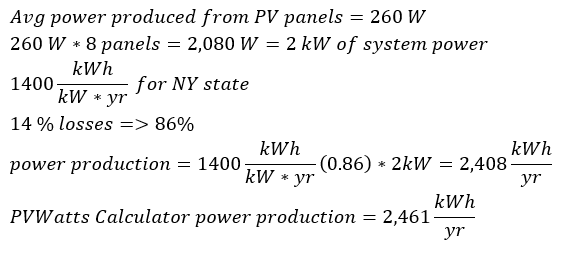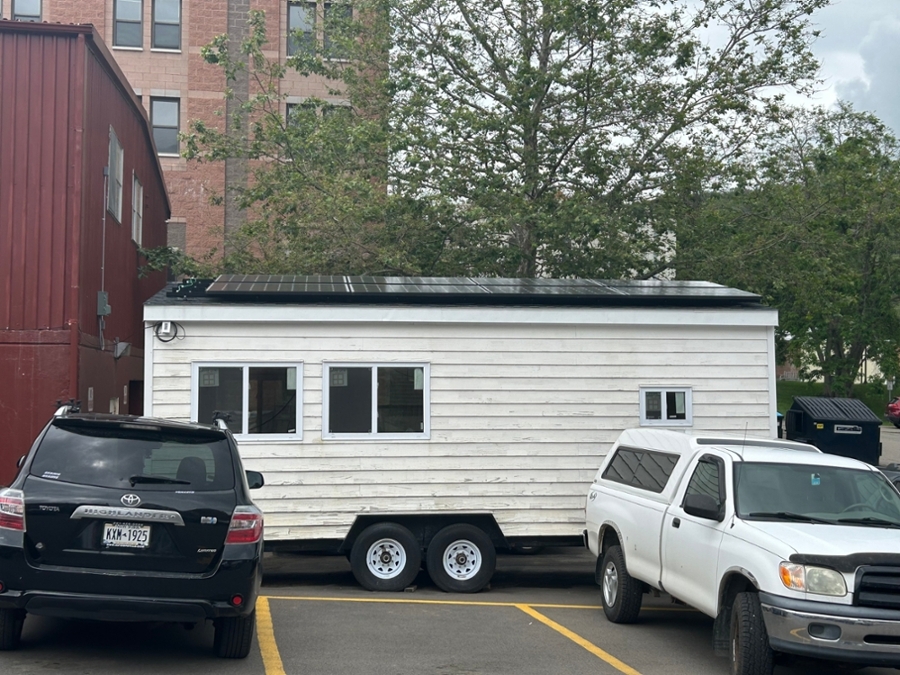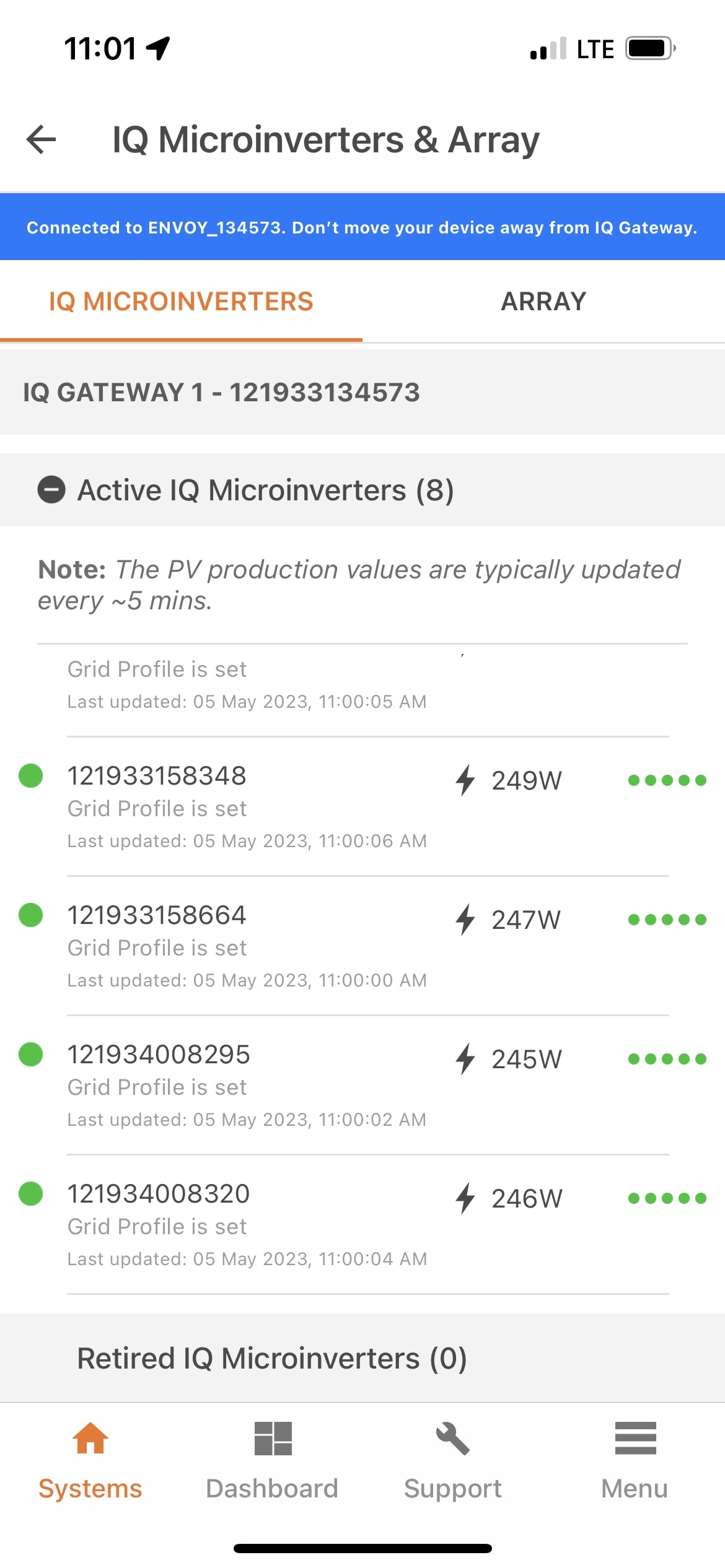PV System & Battery Bank
PV System
Budget
The proposed overall budget for this project is seen in Table 1. Most of the budget will go to the battery bank. The batteries are an important part of the overall system and will allow the system to store enough energy to have months of self-sustainability. With a minimal budget, a lead-acid battery bank system would be ideal because it has a minimal startup cost. A lithium-ion battery is a more efficient system but is a costlier. The lithium-ion is not part of the original design, but the potential buyer of the tiny house wants to have the best available battery technology.
| Cost | Amount ($) |
|---|---|
| Battery Bank | $4800 |
| Lithium-Ion Battery Bank (option) | $14000 |
| Inverter | $2000 |
| Charge Controller | $600 |
| Wiring | $400 |
| Labor of installation | $600 |
| Total w/o LI | $8400 |
| Total w/LI | $17600 |
Potential Problems
There are several problems associated with designing and installing a solar energy system:
- Insufficient energy output from PV panels
- Insufficient energy storage
- DC to AC power inversion
- Insufficient power for amount of load
- Improper installation of system
The Solution
The solution to insufficient energy storage will be explained further in the next section, Battery Bank.
There are solutions to these problems that could occur during the design and installation. The possibility of the solar cells producing insufficient energy output can be solved by having a properly sized PV array. A 2-kW system will be sufficient for the tiny house. The PV system calculations are shown below:

The PVWatts Calculator uses 14% losses and current weather data in Alfred, NY to determine the power production of a PV system. There is only a two percent difference between my calculation and the PVWatts Calculator.
If the tiny house was to be used in a different location outside of Alfred, NY, the power production would change. The closer to the equator, where there is an increase in solar intensity, the more power production. The power production for Rock Island, Tennessee is shown in the following calculations:

This change in location results in an eight percent increase in power production per the PVWatts Calculator. There is a four percent difference between my calculation and the PVWatts Calculator.
The Load
The load that this system will need to support is around 2100 kWh/yr as outlines in Table 2 below.
- The peak value for the load is 1 kilowatt which occurs for 0.1 hours which is the approximate run time of the electric winch.
- The heating unit to originally be used was a propane heater that would draw no electricity from the PV system.
- A PV system producing 2,461 kilowatt hours per year will support the 2100-kilowatt hours per year load of the tiny house. The 12,762-kilowatt hours per year produced with the heating system will not be supported by the tiny house PV system and will not be expected to.
- The heater will only run off the PV system if the tiny house is stationed in Rock Island, Tennessee.
- If it is stationed in Rock Island, there will be an external PV system that will not be part of the tiny house.
| Watts | Hours per Day | Watt Hours per Day | |
|---|---|---|---|
| tankless water heater | 1800 | 1 | 1800 |
| kitchen appliances | 500 | 2 | 1000 |
| laundry | 400 | 1 | 400 |
| entertainment | 200 | 1 | 200 |
| fridge/freezer | 115 | 15 | 1725 |
| lighting | 75 | 6 | 450 |
| heat | 6480 | 4.5 | 29160 |
| electric winch | 746 | 0.1 | 74.6 |
| water pump 1 | 55 | 2.8 | 154 |
| water pump 2 | 362 | 2.8 | 1013.6 |
| total kilowatt hours per day | 34.9636 | ||
| peak value (kWh) | 1.037 | ||
| total kilowatt hrs per year | 12761.714 | ||
| total kwh/yr w/o heat | 2118.314 |
Improper installation of the system can lead to malfunctions and shortages in the system. This can be avoided by having knowledgeable installation professionals install the solar system.
Battery Bank
The problem of insufficient energy storage can cut the self-sustainability time. In which case the tiny house must plug into the grid. The goal is to have maximum amount of self-sustainability time. The solution to this is to properly size the storage system. A 20-kWh storage system will be installed using Full River Battery DC400-6 Deep-Cycle AGM Battery. Battery calculations are shown below:

Battery efficiency, and reliability can be improved by lithium-ion batteries. A lithium-ion battery bank can store the same amount electrical power with having an advantage of efficiency and reliability over a lead-acid battery. Although costlier, it will be able to provide a higher energy density and a lower rate of self-discharge. The calculation below shows the amount of power that can be stored with a Smart Battery 12V 300AH Lithium-Ion Battery:
![]()
DC to AC power inversion is another problem that a PV system faces. For this system, the DC to AC inverter will be used to convert the DC power from the batteries to AC power needed to run everyday items within the tiny house. The inverter that will be used is a 4400W 48VDC Pure Sine Inverter Charger MS-PAE made by Magnum Energy. It will convert 48 volts of DC energy into 120 volts of single phase AC electricity. It will provide a current of 30 Amps.
Panels on the Roof

Readings from the panel


